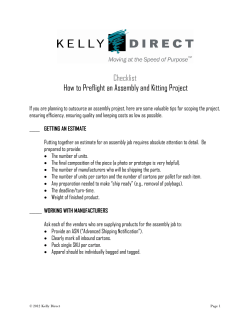
PDF Version - Transports Canada
RDIMS # 10104840 January 2015 Transportation of Dangerous Goods TDG Bulletin Classification Scheme TABLE OF CONTENTS Responsibility 3 Classification Description 4 Alternative Methods 5 Classification Flow-Chart 5 Compliance with the Transportation of Dangerous Goods Act and Regulations 7 Page 2 of 7 This bulletin explains the classification requirements. It does not change, create, amend or suggest deviations to the Transportation of Dangerous Goods (TDG) Regulations. For specific details, consult Part 2 of the TDG Regulations. Classification Scheme The Transportation of Dangerous Goods (TDG) Act divides dangerous goods into nine classes according to the type of danger they present. The nine classes, as well as their divisions, are described in “The Marks of Safety” handout. Responsibility Classification It is the consignor’s (shipper) responsibility to classify a substance, product or organism to determine if it is dangerous goods. A consignor must do all the prep work (or hire someone to do it) before the carrier takes possession of the dangerous goods. Preparing the dangerous goods for transport includes: Classifying the dangerous goods; Completing the documentation; Displaying the dangerous goods safety marks on the means of containment; Selecting a means of containment; Etc Classification is normally done by (or in consultation with): A person capable of understanding the nature of the dangerous goods (e.g. a manufacturer); A person who formulates, blends or otherwise prepares mixtures or solutions of goods; or In the case of infectious substances, a doctor, scientist, veterinarian, epidemiologist, genetic engineer, pathologist, nurse, coroner or laboratory technologist or technician. Proof of Classification A proof of classification is a document a consignor must make available for a period of five years starting on the date that appears on the shipping document to the Minister of Transport Canada on reasonable notice given by the Minister. The proof of classification is in the form of: A test report; A lab report; or A document that explains how the dangerous goods were classified. Page 3 of 7 The proof of classification must include the following information: The date on which the dangerous goods were classified; If applicable, the technical name of the dangerous goods; The classification of the dangerous goods; and If applicable, the classification method used under Part 2 of the TDG Regulations or under Chapter 2 of the UN Recommendations. Classification Description When classifying dangerous goods, the consignor must identify: The shipping name; The primary class; The UN number; and, if applicable, The compatibility group letter; The subsidiary class(es); The packing group; The infectious substance category. 1. The shipping name is the name of the dangerous good as it appears in column 2 of Schedule 1, Classes 1 to 9, of the TDG Regulations. 2. The primary class is the class of dangerous goods that takes precedence over any other class. The subsidiary class is the other class that further identifies the hazards of the dangerous goods. More than one subsidiary class is possible. 3. The UN number is a four digit number that identifies dangerous goods internationally. 4. The compatibility group identifies the types of Class 1 explosives substances and articles that can be transported together without significantly increasing either the probability of an accident or, for a given quantity, the magnitude of the effects of such an accident. It is represented by a letter following the primary class of a Class 1 explosive. 5. The packing group indicates the degree of danger of a product or substance. Packing group I indicates great danger, packing group II indicates moderate danger and packing group III indicates minor danger. 6. Categories A and B are used to classify infectious substances. They are based on their ability to cause a disease, their ability to spread the disease and the severity of that disease. Substances classified as category A indicate greater danger. Page 4 of 7 Alternative Methods Use of Classification The consignor must use the following classifications: For substances included in Class 1, Explosives, the classification determined in accordance with the “Explosives Act”; For radioactive materials, the classification determined in accordance with the “Packaging and Transport of Nuclear Substances Regulations”. The consignor may use the following classification: For substances included in class 6.2 infectious substances, the classification determined by the Public Health Agency of Canada or the Canadian Food Inspection Agency. For transport within Canada by road vehicle, railway vehicle or by ship on a domestic voyage, the consignor may use the classifications in: The International Civil Aviation Organization (ICAO) Technical Instructions; The International Maritime Dangerous Goods (IMDG) Code; or The United Nations (UN) Recommendations. International Transport As per subsection 11.1(1) of the TDG Regulations, the IMDG Code must be consulted for international transport by ship. For transport from the United States into Canada by road vehicle or railway vehicle, the shipping name used must be one that is recognized in Schedule 1, Classes 1 to 9, of the TDG Regulations or in the UN Recommendations. Shipment by Air The ICAO Technical Instructions, as well as, Part 12, Air, of the TDG Regulations must be consulted for all shipments by air. Classification Flow-Chart On the following page, there is a pictorial summary to help consignors use the TDG Regulations to classify dangerous goods for transport. Page 5 of 7 Are the dangerous goods precisely described by the shipping name (and its description) in Schedule 1? YES NO Use the shipping name and its corresponding data (UN number, class, packing group/category). Consult Part 2 - Classification, of the TDG Regulations Ex. UN1203, GASOLINE If it is in Class 1 or 7, it will be classified pursuant to another regulatory authority Classes 2, 3, 4, 5, 6, 8 and 9 have criteria and require tests to be completed. Based on the criteria and test results, three scenarios exist: Falls out of all classes Sec. 2.3 Falls into one class and one packing group Falls into more than one class or packing group Art. 2.5 Sec. 2.4 Not regulated Consult Schedule 1 for the shipping name that most precisely describes the dangerous goods Determine the primary class, subsidiary class(es) and packing group by using section 2.8 Precedence of Classes in Part 2 Consult Schedule 1 for the shipping name that most precisely describes the dangerous goods Use the shipping name and its corresponding data (UN number, class, packing group/category) Ex. UN1993, LIQUID, N.O.S. FLAMMABLE Page 6 of 7 Use the shipping name and its corresponding data (UN number, class, packing group/category) Ex. UN3086, TOXIC SOLIDE, OXIDIZING, N.O.S. Compliance with the Transportation of Dangerous Goods Act and Regulations Failure to comply with the TDG Act and TDG Regulations may lead to fines and/or prison. You can visit the TDG website at: www.tc.gc.ca/tdg. If you have any questions about the TDG Regulations, contact a Transport Canada dangerous goods inspector in your region. Atlantic Region 1-866-814-1477 TDG-TMDAtlantic@tc.gc.ca Quebec Region (514) 283-5722 TMD-TDG.Quebec@tc.gc.ca Ontario Region (416) 973-1868 TDG-TMDOntario@tc.gc.ca Prairie & Northern Region 1-888-463-0521 TDG-TMDPNR@tc.gc.ca Pacific Region (604) 666-2955 TDGPacific-TMDPacifique@tc.gc.ca Page 7 of 7
© Copyright 2025













